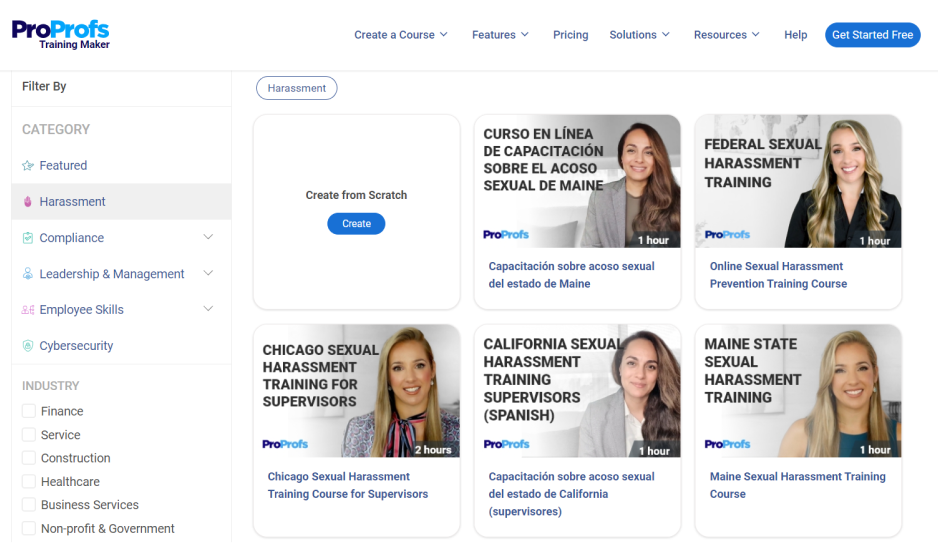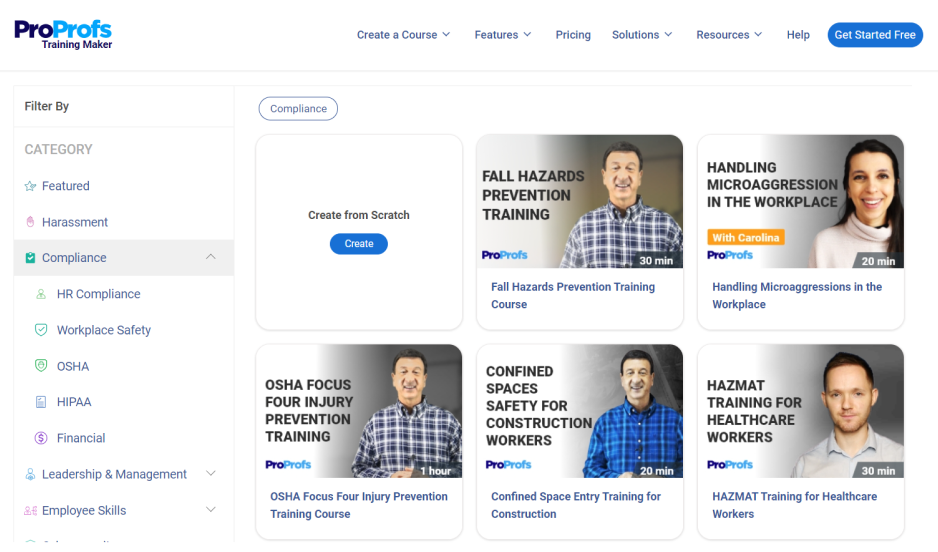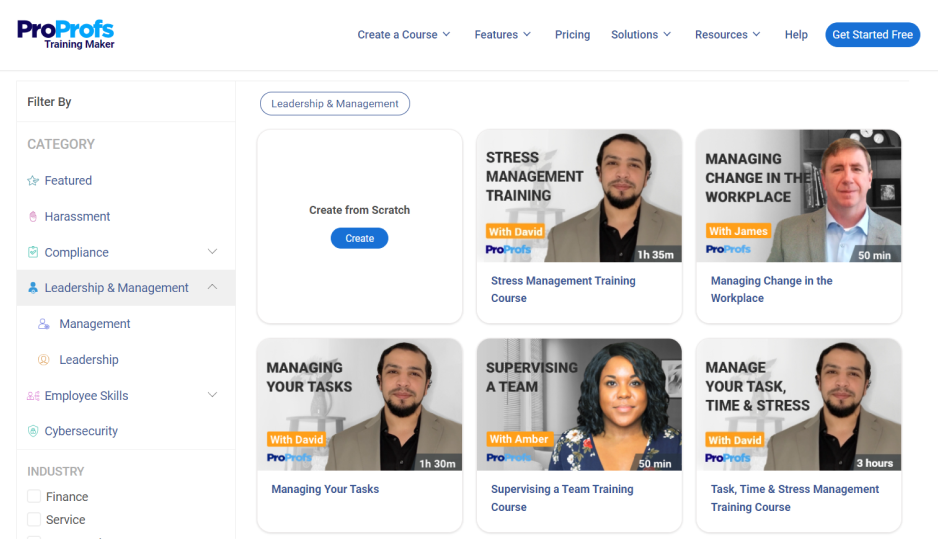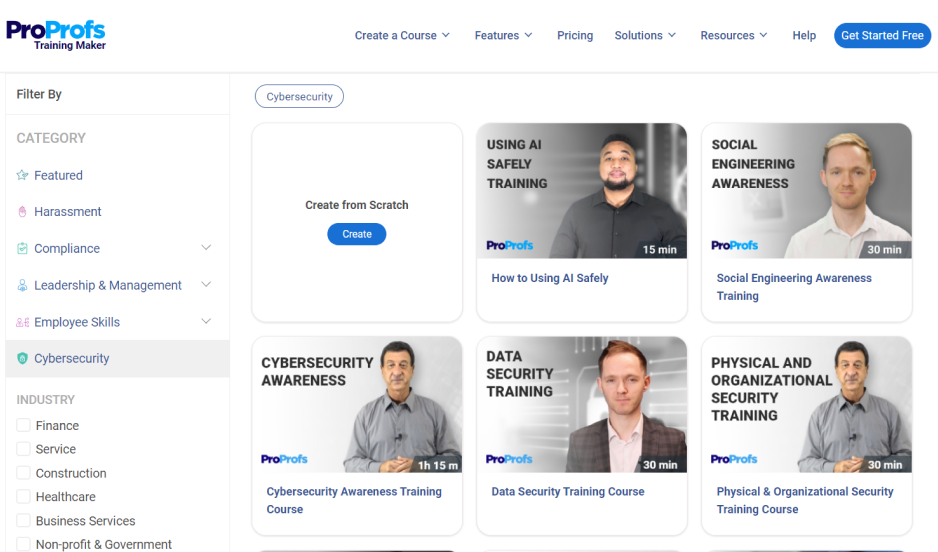“The only thing worse than training your employees and having them leave is not training them and having them stay.” – Henry Ford
The absence of a solid training program for employees is like setting your team up for failure. I’ve seen firsthand how inadequate training can lead to high turnover, inefficiencies, and employee frustration.
When people are left to figure things out on their own, they lose confidence, make mistakes, and miss out on opportunities.
That’s why creating a well-structured training program is essential. In this guide, I’ll walk you through how to create a training program for employees that addresses these pain points, empowers your team to excel, and propels your business.
What Is a Training Program for Employees?
A training program for employees is a structured plan designed to enhance workplace skills, knowledge, and performance.
For example, a retail business can implement a training program to teach sales associates effective customer service techniques, leading to improved customer satisfaction and increased sales. These programs can range from onboarding sessions for new hires to ongoing professional development courses, all tailored to meet specific business goals.
Examples of Training Programs for Employees
Many organizations implement comprehensive training programs that cover essential areas. These programs address critical topics from employee safety to leadership development and skill enhancement.
Below are some key categories:
- Harassment: Guides on recognizing, preventing, and addressing workplace harassment to ensure a safe environment.

- Compliance: Ensures employees understand and follow legal requirements and company policies, reducing the risk of violations.

- Leadership & Management: Develops leadership skills, helping managers and executives lead teams effectively and make strategic decisions.

- Employee Skills: Improve performance by enhancing core competencies like communication, problem-solving, and time management.

- Cybersecurity: Educates on protecting digital assets, recognizing cyber threats, and following best practices for data security.
What Are the Benefits of Creating a Training Program for Employees?
Consider a scenario where you’re preparing a new recipe for the first time. You have all the ingredients laid out, but without a clear recipe, you might be unsure of the correct measurements or cooking techniques.
The result?
It’s an undercooked or overseasoned dish that just doesn’t taste right.
This analogy applies to employee training. Employees are like cooks, and their tasks are the recipes.
With a comprehensive training program, employees have a clear guide—a “recipe”—outlining each step, task approach, and the best practices to achieve the desired outcomes.
With that, let’s understand the other benefits that training programs for employees offer:
1. Sharpen Your Leadership Skills
As a trainer, you’re not just teaching but leading the charge! Think of it as a real-life “Follow the Leader” game where your team hangs on your every word (or at least, that’s the goal).
You naturally refine your leadership abilities by guiding your employees through new skills and processes. Plus, nothing says “I’ve got this,” like a room full of people actually understanding what you’re saying!
2. Get a Front-Row Seat to Business Growth
Creating a training program for employees isn’t just about improving others—it’s a chance to deepen your understanding of the business. You see the bigger picture when you explain why certain practices are crucial.
And let’s face it, being the teacher who “knows all” comes with a certain level of street cred. A study even found that employee productivity can jump by 17% with effective training, so your efforts have a serious payoff!
3. Boost Employee Loyalty (and Your Sanity)
Ever feel like you’re stuck in an endless loop of hiring and training? Good news: well-trained employees are 90% more likely to stick around, which means less time spent on hiring and more on building a cohesive, efficient team. In short, a solid training program is a win-win for everyone involved.
Plus, it’s always nice when your team knows what they’re doing without needing constant hand-holding.
4. Master the Art of Patience (Without Losing Your Mind)
Training isn’t always a walk in the park; it requires patience and communication. But here’s where the silver lining comes in: with each question you answer, you refine these essential skills, becoming a trainer and a more effective communicator overall.
By the end of it, you’ll have mastered the art of clarity and patience—invaluable qualities in any professional setting.
5. Establish Yourself as an Organizational Pillar
In leading training programs, you establish yourself as an indispensable resource within the organization.
You ensure that employees are equipped to perform at their best, earning you the respect and recognition of your peers and leadership. It’s not just about teaching—it’s about being a cornerstone of your company’s success.
6. Enjoy the Perks of an Engaged Workforce
When you train employees well, you teach them skills and build a more engaged workforce. And here’s the kicker: companies with highly engaged employees are 21% more profitable.
So not only do you get to see your trainees thrive, but you also get to enjoy the sweet satisfaction of contributing to the bottom line. Who said training wasn’t rewarding?
Importance of Well-Designed Training Programs
If you ask me, I’d simply talk stats, which explains why well-designed training programs are crucial. 94% of employees said they would stay if their company prioritized their growth. This is big because it highlights the direct correlation between employee development and retention.
Having said that, let’s quickly check out why it is essential to have well-designed training programs.
1. Supercharges Employee Performance
Imagine a well-designed training program as the turbocharger for your employees. By equipping them with the right tools and knowledge, you’re helping them do their jobs and enabling them to do their jobs exceptionally well.
In fact, a slight boost in training investment can lead to an 8.6% surge in productivity. Not too shabby, right?
2. Keeps Compliance (and Headaches) in Check
Nobody likes dealing with compliance issues, especially the fines and headaches that come with them. But here’s the good news: a well-structured training program for employees ensures they know and follow the rules, reducing the risk of costly mistakes.
Consider it as giving your team the ultimate rulebook for staying out of trouble, whether in healthcare, finance, or any other highly regulated industry.
3. Makes Tech Transitions a Breeze
Technology is like that friend who’s always ahead of the curve—getting the latest gadget and talking about the next big thing. Keeping up can be exhausting. But with a well-designed training program, your employees can quickly adapt to new technologies.
It’s like giving them a roadmap to navigate the ever-changing tech landscape, ensuring they stay sharp and your business stays competitive.
4. Boosts Employee Loyalty (Because Who Doesn’t Love Feeling Valued?)
Investing in your employees’ growth is like giving them the best kind of gift—one that keeps on giving. When employees feel valued through ongoing training, they’re more likely to stick around, reducing turnover rates and saving you the hassle of constant recruiting.
Companies with solid training programs see 30-50% higher retention rates, meaning your team is more likely to grow with you than grow out of you.
5. Grows With Your Company (Like a Trusted Sidekick)
As your company expands, so does the need for consistent training across the board. A well-designed program is like your reliable sidekick, ready to scale with your business.
This ensures everyone is on the same page—whether in the same office or halfway across the globe. Consistency is key to maintaining the quality and efficiency needed to reach organizational goals.
6. Future-Proofs Your Business With Knowledge Transfer
Your training program is like a time machine for knowledge. It captures the wisdom of experienced employees and passes it down to the next generation, ensuring that valuable know-how doesn’t retire when they do.
Plus, it prepares your future leaders, ensuring your business doesn’t miss a beat when it’s time for the next wave of talent to take the helm.
Get Free Employee Training Software — All Features, Forever.
We've helped 567 companies train 200,000+ employees. Create courses in under a minute with our AI LMS or use 200+ ready-made courses on compliance, harassment, DEI, onboarding, and more!
What Are the Key Elements of a Successful Training Program?
Training programs can indeed benefit employees and organizations.
But these advantages don’t happen by chance. The real impact of training programs comes from their composition. They must include all the essential elements that address the needs of both the learners and the organization.
That’s why I’ve listed the key elements that every successful training program for employees must include.
1. Clear Objectives
An employee training program is like a journey. Your team could get lost without a map (or clear objectives).
Define your destination with SMART goals—Specific, Measurable, Achievable, Relevant, and Time-bound—to keep everyone on track.
2. Content That Matters
A key element to a successful training program is the content you create. No one wants to sit through hours of irrelevant information.
Tailor your training content to address the real challenges your team faces. Keep it relevant, and you’ll have them hooked from the start.
3. Collaboration Opportunities
Ditch the boring lectures. Engage your audience with various methods—think games, hands-on activities, and multimedia presentations.
When learning is fun, it sticks!
4. Right Mentors
Your trainers should be more than just experts; they must be great storytellers.
The right instructor can turn complex topics into memorable lessons, thus making the training highly effective.
5. Practical Assessments
Theory is great, but practice makes perfect.
Create a training program that gives your team opportunities to apply what they’ve learned through real-life scenarios or simulations. This way, they can see the impact of their new skills in action.
6. Reports and Analytics
Keep the momentum going with regular check-ins. Use quizzes, challenges, or practical tasks to assess understanding.
And don’t forget feedback—constructive and timely advice helps everyone improve.
Don’t know how to give great feedback, I have a great resource for you:
7. Post-Training Resources
The learning shouldn’t stop when the session ends. That’s the beauty of effective training programs.
Offer follow-up resources, like online tools or mentoring, to help participants continue growing. A little extra support goes a long way.
8. Diversity and Inclusion
Create a learning environment where everyone feels valued.
Incorporate diverse perspectives when developing a training program. Cultural sensitivity should also be ensured to make the training program a positive experience for all.
With these critical elements in place, your training program for employees will bring success. But understanding these elements is just the beginning. To truly get your training program to life, you need a straightforward, step-by-step approach to implementation.
How to Create Training Programs for Employees: 8 Essential Steps
Now that we’ve covered the essential building blocks, let’s move on to the practical side—how to combine these elements to create a training program for employees. Short on time? Learn how to create effective employee training programs in just 60 minutes.
Want to look at all the steps in detail? Whether starting from scratch or refining an existing program, these steps will guide you through the process of creating a training program, ensuring your training initiative delivers real results.
1. Needs Assessment
A study by the Association for Talent Development (ATD) found that organizations that conduct thorough needs assessments are 70% more likely to achieve their business goals.
- Identify Training Gaps: Conduct a thorough analysis to determine the specific skills and knowledge gaps that must be addressed. This can be done through surveys, interviews, performance reviews, and observations.
- Prioritize Training Needs: Based on the identified gaps, an effective training program must prioritize the most critical areas. Consider factors such as business objectives, employee performance, and regulatory requirements.
2. Learning Objectives
“A goal without a plan is just a wish.” – Antoine de Saint-Exupéry. This is precisely what the next step is about. Without setting clear objectives, it’s challenging to achieve the learning outcomes.
- Define Clear Goals: Clearly articulate the desired outcomes of the training program. These objectives should be specific, measurable, achievable, relevant, and time-bound (SMART).
- Align With Business Goals: Ensure the training objectives align with the business strategy and goals.
3. Curriculum Development
The next step is all about curating your curriculum. Research shows that turnover rates are reduced when training programs are relevant to their job roles and responsibilities.
- Content Selection: Gather relevant content, including instructional materials, case studies, simulations, and assessments.
- Sequence and Delivery: Determine the optimal sequence of topics and the most effective delivery methods (e.g., classroom training, online courses, workshops, or blended learning).
- Technology Integration: Consider incorporating technology tools like learning management systems (LMS), virtual reality (VR), or augmented reality (AR) to enhance engagement and accessibility.
4. Instructor Selection and Training
Good teachers know how to bring out the best in their students.”—Charles Dickens. The same applies to employee training. This is why I always insist others find a reputed and certified instructor.
- Qualifications and Experience: Choose instructors with the expertise and experience to deliver the training content effectively.
- Training and Certification: Provide instructors with the appropriate training and certification to ensure they are equipped to facilitate the program.
5. Pilot Testing
How can you be confident that your program will deliver the desired outcomes without trying it out first?
Conducting a pilot test can help identify potential weaknesses and make necessary adjustments before rolling out the program to a larger audience.
- Evaluate Effectiveness: Conduct a pilot test with a small group of employees to assess the effectiveness of the training materials, delivery methods, and overall learning experience.
- Gather Feedback: Collect feedback from pilot participants to identify areas for improvement and make necessary adjustments.
6. Implementation and Delivery
Another study by the ATD found that employees are more likely to participate in training programs when they are scheduled at convenient times.
- Scheduling and Logistics: Schedule training sessions so they fit into employees’ work schedules with minimal disruption. You can use training calendars for this.
- Facilities and Resources: Ensure adequate facilities, equipment, and resources are available for the training program.
- Delivery: Deliver the training program according to the planned curriculum, using engaging and interactive methods. (I always prefer using an LMS, you can try it as well)!
7. Evaluation and Measurement
A study by Deloitte found that organizations that measure the effectiveness of their training program for employees are more likely to see a return on investment.
- Pre- and Post-Training Assessments: Administer assessments to measure participants’ knowledge and skills before and after the training.
- Performance Metrics: Track changes in employee performance after the training to assess its impact on job effectiveness.
- Feedback Surveys: Collect feedback from participants and managers to evaluate the training program’s effectiveness and identify areas for improvement.
8. Continuous Improvement
Let’s be very honest: training programs require continuous adaptation and refinement. Here is the last step, which talks about prioritizing continuous improvement so your training programs are sustainable and responsive to the changing needs of the workforce as well.
- Review and Update: Regularly review and update the training program to ensure it remains relevant and effective.
- Adapt to Changes: Adjust the program as business needs and employee requirements evolve.
How to Evaluate Training Programs
So, we’ve come to the section about “effectiveness.” When this word comes to my mind, many things pop up—how do we know if something is working? How do we measure success in a meaningful way?
Evaluating the effectiveness of a training program isn’t just about checking the boxes but also about understanding its impact on your team and your business. Let’s break it down.
1. Kirkpatrick’s Four-Level Evaluation Model
Level 1: Reaction
This is the initial pulse check. How did participants feel about the training? Were they engaged? Did they find the material relevant? Gathering this feedback through surveys and forms can give you immediate insights into what worked and what didn’t.
Level 2: Learning
Here, we’re talking about knowledge transfer. Did participants learn what they were supposed to? Using pre- and post-training assessments or quizzes, you can quantify the increase in knowledge or skills. This is where you see if your content is truly sinking in.
Level 3: Behavior
This is where the rubber meets the road. Are participants applying what they learned on the job? Behavioral changes are often subtle, so using tools like 360-degree feedback, peer reviews, or even simple observation to track these shifts over time is essential.
Level 4: Results
Finally, it’s all about the bigger picture. What impact has the training program for employees had on your business outcomes? Whether it’s increased productivity, fewer errors, or happier customers, this level of evaluation tells you if the training contributes to the bottom line.
2. ROI Analysis
- Cost-Benefit Ratio
ROI is a tangible metric that shows whether your training is worth the investment. By comparing the financial benefits derived from the training against the costs, you can see a clear picture of the program’s value.
The formula is simple: ROI (%)=Net Benefits/Total Costs×100
- Benefit Quantification
This is where we get into the nitty-gritty. Consider the specific benefits your training has provided—whether it’s faster project completion, reduced errors, or increased sales—and assign a monetary value to each. Then, stack these benefits up against the training costs to see if you’re in the green zone.
3. Pre- and Post-Training Performance Metrics
- Benchmarking
Before you start training, set a baseline. Where are your employees in terms of performance? After the training, measure the same metrics to see where improvements have occurred. This comparison will help quantify the impact of training.
- Data Analytics
With today’s technology, why not use data analytics tools to track these changes over time? You can even apply statistical methods like regression analysis to see how closely the training correlates with performance improvements.
4. Employee Retention and Engagement
- Retention Rates
By analyzing retention rates before and after training, you can see if there’s a connection. High retention often indicates that employees feel more satisfied and valued after training.
- Engagement Surveys
Surveys are a great way to gauge your employee feelings. Are they more engaged and motivated post-training? A well-designed engagement survey can help you measure this and identify areas for further improvement.
5. Competency Mapping
- Competency Gap Analysis
Imagine your training as a bridge over a competency gap. Before the training, identify where these gaps exist. Post-training, measure how much of that gap has been closed. This gives you a clear indication of the training’s effectiveness in enhancing specific skills.
- Skill Assessments
Standardized skill assessments can be your go-to tool here. They provide objective data on how much participants have improved in key areas, helping you see the direct impact of your training efforts.
6. Longitudinal Studies
- Follow-Up Studies
Sometimes, the true impact of training takes time to reveal itself. That’s why conducting follow-up studies is so important. Periodically check in to see if the benefits of the training are sustained over the long term. This will give you a more complete picture of its effectiveness.
- Trend Analysis
Analyzing trends over extended periods lets you see if the initial improvements stick around. This long-term view is crucial for understanding the lasting impact of your training program.
7. Advanced Analytical Techniques
- Machine Learning Models
Why stop at traditional methods when you can harness the power of machine learning? By analyzing historical data, machine learning models can predict the long-term outcomes of your training, helping you refine future programs for even greater success.
- Data Visualization Tools
Dashboards aren’t just for show—they’re powerful tools that allow you to track training effectiveness in real-time. You can make informed decisions that drive continuous improvement by visualizing trends, outliers, and key performance indicators.
By integrating these methods, you ensure that your employee training program drives measurable results that align with your business goals. The key is to stay engaged, use the right tools, and keep the focus on both immediate and long-term impacts.
Ready to Create an Impactful Training Program for Employees?
So, you’ve now got the blueprint for creating a robust training program for employees that can transform your workforce.
But here’s the catch: having this guide is just the beginning. Will you take the leap and implement these strategies, or will your team continue to struggle without a clear direction?
The choice is yours, but remember, a day without a solid training program is lost in potential growth.
Don’t let your competitors get ahead—take action now and watch your organization soar. The clock is ticking, and your team’s future depends on the decisions you make today.







 We'd love your feedback!
We'd love your feedback! Thanks for your feedback!
Thanks for your feedback!








